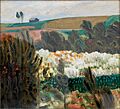Konrad Mägi facts for kids
Quick facts for kids
Konrad Mägi
|
|
|---|---|

Konrad Mägi (photo c. 1898–1905)
|
|
| Born |
Konrad Vilhelm Mägi
1 November 1878 Hellenurme Manor, Elva Parish, Governorate of Livonia
|
| Died | 15 August 1925 (aged 46) |
| Nationality | Estonian |
| Movement | Expressionism |
Konrad Vilhelm Mägi (born November 1, 1878 – died August 15, 1925) was a famous Estonian painter. He is best known for his amazing landscape paintings. Konrad Mägi loved using bright colors. His paintings of the Saaremaa island are considered the first modern nature paintings from Estonia.
Konrad Mägi's Artistic Journey
Konrad Mägi started learning art in Tartu between 1899 and 1902. He took drawing classes at the German Artisans' Society. Besides art, he also loved theater, playing the violin, and different sports.
He continued his art studies in Saint Petersburg from 1903 to 1905. There, he learned from the artist Amandus Adamson. In the autumn of 1907, Mägi moved to Paris, France. He studied art at a special academy there. From 1908 to 1910, he lived in Norway. In 1912, Mägi came back to Tartu, Estonia, where he worked as an art teacher.
While in Åland, Mägi created beautiful plant drawings. These drawings had a delicate, flowing style called Art Nouveau. An example is his ink drawing Kahekesi (Two together) from 1908.
In Paris, Mägi was inspired by two art styles: Impressionism and Fauvism. These styles greatly influenced how he used colors in his paintings. You can see this in works like Lilleline väli majakesega (A flower field with a little house) from 1908–1909. Another example is Norra maastik männiga (A Norwegian landscape with a pine) from 1910.
After 1918, Mägi's art showed the influence of Expressionism. This style came from his deep feelings and how he reacted to the difficult times. Paintings like Pühajärv (Lake Püha) (1918–1920) and Otepää maastik (Landscape of Otepää) (1918–1920) show this. His large paintings with figures, Pietà (1919) and Kolgata (Golgatha) (1921), also have an Expressionist feel.
Mägi's trip to Italy started a new, calmer period in his art. His painting Varemed Capril (Ruins in Capri) from 1922–1923 shows this change. Besides nature scenes, he also painted flowers and portraits of people. Many of his portraits feature beautiful women, showing the ideal beauty of the Art Nouveau period, like Holsti (1916). In his later portraits from the 1920s, like Madonna (1923–1924), you can see a more serious mood.
Gallery
-
Motif from Saaremaa (date unknown)
See also
- Culture of Estonia

















